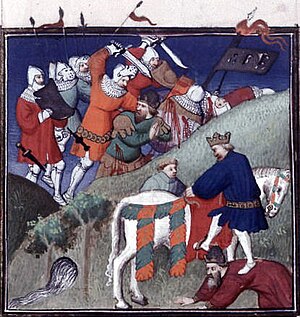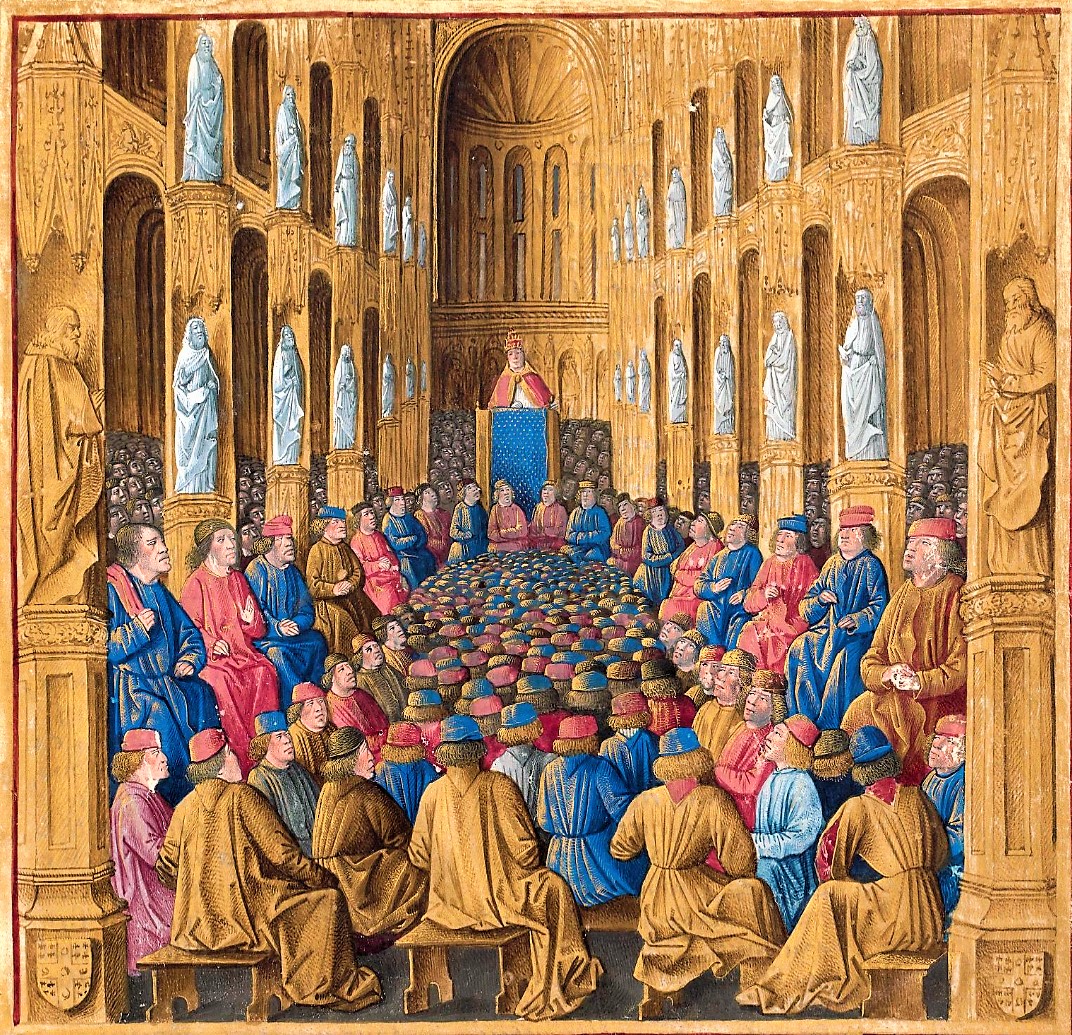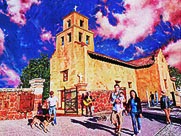Click here to return to 12) Ecumenicism, Schism, and Call to Islam
Church of the Holy Sepulchre
Consequently, some western historians today refer to Caliph Al-Ḥākim as the “Mad Caliph”. Still, there exists an often-overlooked article of Sunni orthodoxy, which strictly forbids building structures over graves, or the veneration of graves as a place of worship. However, this would not have justified the desecration of Christ’s tomb. Christ is a venerated prophet within Islamic belief. Moreover, Muslims may still respect tombs. They simply cannot turn them into objects of worship. An example of this would be the Umayyad Mosque in Damascus, Syria, which housed the remains of John the Baptist, until its unfortunate destruction in April of 2013, during the Syrian Civil War.
The church was rebuilt at considerable expense to his successor, Eastern Emperor Constantine IX Monomachos in 1048. In return, the Empire permitted the reopening of the mosque in Constantinople. However, good news travels at a considerably slower pace so, outside of local residents, immediate pilgrims and members of the clergy, few Europeans became aware of this accord.
Impact
As if to confirm the Second Coming, the 11th century would witness a progressive failure to the overall infrastructure created by Charlemagne and reasserted by Otto. Organized rule was once again in decline.
By 1073, Pope Gregory VII and the Frankish Holy Roman Emperor Henry IV would challenge each other's authority. Henry would increase his influence within the church by establishing new counties, which would require new bishops. He would then appoint the bishops, loyal to himself. The row eventually developed into what is today known as the Investiture Controversy. Subsequently, the Pope and Henry's bishops were preoccupied with excommunications and antipopes.
Meanwhile, even with the agricultural innovation of three-field crop rotation a couple centuries earlier, population growth of a developing Europe had outstripped its ability to produce sufficient food. Grain and vegetables would not become common foodstuff until the 13th century. As a result, the whole of 11th century Europe would suffer from malnutrition, if not borderline famine. Not only was pope and throne preoccupied, feudal lords, along with knights and mercenaries, were either attacking neighboring clans or pillaging the countryside for livestock and loot.
Consequently, the events of the 11th century combined with the newly formulated feudal system and its institution of knighthood would determine the course of European history for the next several centuries.
Olive Branch
Just six years later, in 1077, the Seljuk Turks would press their advance to the suburbs of Constantinople and claim the holy city of Nicaea, home of the First Ecumenical Council (The Council of Nicaea). By 1095, Emperor Alexius I Comnenus would contact Pope Urban II to request military aid to help hold the line.
Since the time of Constantine the Great, the Eastern Emperor's involvement as Pontifex Maximus had considerable impact on the falling out between the Eastern Greek and Western Latin churches. Ironically, the emperor had not been involved in the events immediately surrounding the Great Schism of 1054. Therefore, Alexius obviously felt particularly comfortable contacting the Pope without any patriarchal involvement from his own Eastern Church. Pope Urban must have viewed the arrival of the emperor's envoys as an olive branch to restore something of a renewed relationship.
No doubt, the pope was flattered, as he now saw himself in a somewhat reversed role of granting a request to the emperor. He may have even considered the gesture to be from a now humbled emperor, viewing himself as promoted above the papacy's old ecclesiastical rivals, the Eastern Patriarchy. Considering the history, this wouldn't have been a stretch.
The Council of Clermont
As a bonus, Urban would clear the rogue knights and assorted rabble from the European countryside by enlisting all manner of Christians in an armed pilgrimage to the Holy Land.
In November of 1095, Pope Urban II made an address to a vast crowd assembled at the Council of Clermont. In that speech he indicated that Europe was “...too narrow for your (its) population”, that it didn’t “...abound in wealth”, and that “...you murder one another, that you wage war, and that frequently you perish by mutual wounds.” He then suggests an alternative and that they “Enter upon the road to the Holy Sepulchre; wrest that land from the wicked race (Islam).” and “Let those who have been fighting against their brothers and relatives now fight in a proper way against the barbarians.”
The throngs of attendees were then reported as shouting the reply, “It is the will of God!” (Deus vult). This would become the catch phrase for the Crusades. Urban went on to state that participants who die would have “...immediate remission of sins” (known in the Church as Plenary Indulgences). He characterizes the Muslims as "demon worshipers" and "barbarians", describing his appeal for a “war, which should have begun long ago.”
Commentary
The initial wave of the First Crusade would be known as the Paupers' Crusade, mainly because it was composed of poor, untrained recruits for the eastern empire to feed, house and train. Subsequently, considerable tragedy would befall the participants and those unfortunate enough to be in their path. The second expedition would consist of mostly four armies of professional knights and foot soldiers that would combine forces upon arrival in Constantinople.
Unlike the Paupers' Crusade, the second wave of the First Crusade, also known as the "Princes' Crusade", would witness their share of victories. However, the barbarism resulting from perpetuated plenary indulgences provided by Pope Urban II, would result in considerable death and destruction to non-combatants and their property, both during the journey and upon arrival. The Crusaders would even sink to cannibalism in the town of Ma'arra in 1099, to which Pope Urban was later quoted referring to it as "...a cruel necessity". Sadly, Pope Urban II would be beatified by the Roman Catholic Church in 1881.
Click here for 14) The Paupers' Crusade
Got Feedback?
Comments? Questions? Corrections? Any feedback at all? Just click on the comments box at the bottom of this page and enter your thoughts. All comments are welcome.
Santuario de Guadalupe, the oil painting by Tom Mallon. This 42" x 22" canvas is the latest addition to the Santa Fe Portrait Series. The Santuario is the oldest shrine to Our Lady of Guadalupe in the US.
Visit this later update by CLICKING HERE
Shostakovich and Cultural Snobbery, Could anyone survive Stalin's Purges, compose a large body, write for himself and the masses while producing constantly great work?
Visit this later update by CLICKING HERE
Also of interest…
Tom Mallon's website "MallonArt". This website will provide you with links to all his paintings, drawings and other artwork portfolios, including the ongoing series entitled the Santa Fe Portrait.
Visit this later update by CLICKING HERE
 |
| Church of the Holy Sepulchre |
Destruction and Desecration
In 1009, thirteen years into his reign, Fatimid Caliph Al-Ḥākim bi-Amr Allah ordered the destruction of all Christian places of worship within his kingdom. Subsequently, the Church of the Holy Sepulchre, built upon the remains of Mount Calvary (Golgotha) and the tomb of Jesus Christ, was burnt to the ground and then hacked to its bedrock foundation. |
| Caliph Al-Ḥākim bi-Amr Allah |
Motivation
The motives for Caliph Al-Ḥākim's (whose name literally translates to “Ruler by God’s Command”) decree remain unclear. From the early days of Islam, Muhammad had always respected Christian and Jewish places of worship. In 622, he formulated his own Edict of Milan with the Constitution of Medina, which provided religious freedom for both Christians and Jews.Consequently, some western historians today refer to Caliph Al-Ḥākim as the “Mad Caliph”. Still, there exists an often-overlooked article of Sunni orthodoxy, which strictly forbids building structures over graves, or the veneration of graves as a place of worship. However, this would not have justified the desecration of Christ’s tomb. Christ is a venerated prophet within Islamic belief. Moreover, Muslims may still respect tombs. They simply cannot turn them into objects of worship. An example of this would be the Umayyad Mosque in Damascus, Syria, which housed the remains of John the Baptist, until its unfortunate destruction in April of 2013, during the Syrian Civil War.
 |
| Reconstructed Church of the Holy Sepulchre |
Reconstruction
So stunned were western Christians, few came to hear of the shrine’s eventual reconstruction. In 1027 an agreement was reached between Al-Ḥākim’ son, Caliph Ali az-Zahir and the Byzantine Emperor Romanus III.The church was rebuilt at considerable expense to his successor, Eastern Emperor Constantine IX Monomachos in 1048. In return, the Empire permitted the reopening of the mosque in Constantinople. However, good news travels at a considerably slower pace so, outside of local residents, immediate pilgrims and members of the clergy, few Europeans became aware of this accord.
 |
| The Emperor Investing a Bishop |
Chaos and Anarchy
The reaction to the Church’s burning at the site of the crucifixion and physical hacking of the temporal resting of Jesus was that of shock and implausible loss. Subsequently, the Church would confound the horror by proclaiming the action to be the work of Revelations’ foretold Antichrist. Consequently, many Christians would conclude a calamitous end to be at hand.As if to confirm the Second Coming, the 11th century would witness a progressive failure to the overall infrastructure created by Charlemagne and reasserted by Otto. Organized rule was once again in decline.
By 1073, Pope Gregory VII and the Frankish Holy Roman Emperor Henry IV would challenge each other's authority. Henry would increase his influence within the church by establishing new counties, which would require new bishops. He would then appoint the bishops, loyal to himself. The row eventually developed into what is today known as the Investiture Controversy. Subsequently, the Pope and Henry's bishops were preoccupied with excommunications and antipopes.
 |
| Detail of Medieval Farming Calendar |
Consequently, the events of the 11th century combined with the newly formulated feudal system and its institution of knighthood would determine the course of European history for the next several centuries.
 |
| Battle of Manzikert |
Call for Help
By the end of the century, the Byzantium Empire was collapsing due to constant warfare with the Seljuq Turks. Having lost the Battle of Manzikert in 1071, the Eastern Empire would be forced to concede the large eastern province of Anatolia and the smaller state of Armenia to Islam. The historian John Julius Norwich sites the Empire’s defeat as “its death blow’” and the subsequent loss of Anatolia as “the greatest disaster suffered by the Empire in seven and a half centuries of existence.” With the loss of numerous ports and commerce centers, Emperor Alexios’ daughter Anna Komnene would write “...the fortunes of the Roman Empire had sunk to their lowest ebb.”Just six years later, in 1077, the Seljuk Turks would press their advance to the suburbs of Constantinople and claim the holy city of Nicaea, home of the First Ecumenical Council (The Council of Nicaea). By 1095, Emperor Alexius I Comnenus would contact Pope Urban II to request military aid to help hold the line.
 |
| Medieval Pope |
No doubt, the pope was flattered, as he now saw himself in a somewhat reversed role of granting a request to the emperor. He may have even considered the gesture to be from a now humbled emperor, viewing himself as promoted above the papacy's old ecclesiastical rivals, the Eastern Patriarchy. Considering the history, this wouldn't have been a stretch.
 |
| Council of Clermont |
Deus vult (God’s Will)
Coming to the aid of the emperor would not only renew ties with the East, it could also help unify Europe against one common enemy, Islam.As a bonus, Urban would clear the rogue knights and assorted rabble from the European countryside by enlisting all manner of Christians in an armed pilgrimage to the Holy Land.
 |
| Pope Urban II on Pulpit |
The throngs of attendees were then reported as shouting the reply, “It is the will of God!” (Deus vult). This would become the catch phrase for the Crusades. Urban went on to state that participants who die would have “...immediate remission of sins” (known in the Church as Plenary Indulgences). He characterizes the Muslims as "demon worshipers" and "barbarians", describing his appeal for a “war, which should have begun long ago.”
 |
| Illuminated Manuscript of Crusades |
Enter the Crusades
The term "Crusades" is derived from the Frank "Croisade" as well as the Spanish "Cruzade". They are both derivations of the Latin word "crux", "cruc" for "cross". Ultimately, Pope Urban would succeed in cleaning up Europe's streets by packing off the poor, the depraved, and unemployed knights to the Holy Land.The initial wave of the First Crusade would be known as the Paupers' Crusade, mainly because it was composed of poor, untrained recruits for the eastern empire to feed, house and train. Subsequently, considerable tragedy would befall the participants and those unfortunate enough to be in their path. The second expedition would consist of mostly four armies of professional knights and foot soldiers that would combine forces upon arrival in Constantinople.
Unlike the Paupers' Crusade, the second wave of the First Crusade, also known as the "Princes' Crusade", would witness their share of victories. However, the barbarism resulting from perpetuated plenary indulgences provided by Pope Urban II, would result in considerable death and destruction to non-combatants and their property, both during the journey and upon arrival. The Crusaders would even sink to cannibalism in the town of Ma'arra in 1099, to which Pope Urban was later quoted referring to it as "...a cruel necessity". Sadly, Pope Urban II would be beatified by the Roman Catholic Church in 1881.
Click here for 14) The Paupers' Crusade
Got Feedback?
Comments? Questions? Corrections? Any feedback at all? Just click on the comments box at the bottom of this page and enter your thoughts. All comments are welcome.
Santuario de Guadalupe, the oil painting by Tom Mallon. This 42" x 22" canvas is the latest addition to the Santa Fe Portrait Series. The Santuario is the oldest shrine to Our Lady of Guadalupe in the US.
Visit this later update by CLICKING HERE
Shostakovich and Cultural Snobbery, Could anyone survive Stalin's Purges, compose a large body, write for himself and the masses while producing constantly great work?
Visit this later update by CLICKING HERE
Tom Mallon's website "MallonArt". This website will provide you with links to all his paintings, drawings and other artwork portfolios, including the ongoing series entitled the Santa Fe Portrait.
Visit this later update by CLICKING HERE




No comments:
Post a Comment